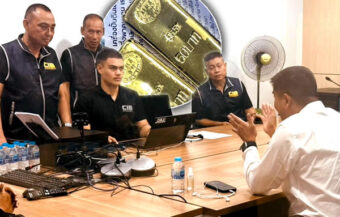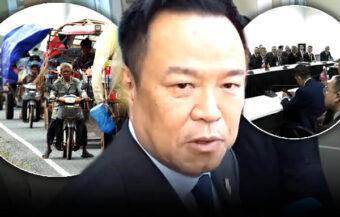Economy showed 3% growth in the first 6 months but faces falling tourism, weak exports and 13 months of shrinking bank lending. Economists urge printing money and letting the baht fall to boost liquidity, exports and tourism under new Governor Vitai Ratanakorn.
Thailand’s economy may have clocked 3% growth in the first half of 2025, but the warning lights are flashing. Tourism is sliding, exports are weakening and banks are pulling back credit for the 13th month straight. The Finance Minister still insists on hitting 2.3% growth this year, but the cracks are widening fast. Pressure is mounting for bold action and the spotlight is now on quantitative easing—essentially printing money and letting the baht fall. That would pump liquidity into the system and make exports and tourism more competitive. For many economists, the time for drastic measures is now. With Vitai Ratanakorn taking over as Bank of Thailand Governor on October 1st, the door to unconventional policy may be about to swing open.

As the Bank of Thailand governor prepares to step down on October 1, pressure is mounting. Incoming Governor Vitai Ratanakorn inherits an economy facing rising financial risks, falling lending and renewed fears of stagnation.
For over a year, Thai banks have withdrawn liquidity from the system instead of injecting it. This is not typical behaviour in an economy needing stimulus. In fact, banks have reduced lending for 13 consecutive months. Signs suggest they will keep pulling back through the end of 2025.
Falling tourism exports and rising debt combine with external shocks to slow Thailand’s growth rapidly
Meanwhile, concerns are rising over deteriorating credit conditions. Bad debt levels are increasing sharply. Medium and even large corporate borrowers are showing early signs of stress. This is alarming, particularly given that Thailand’s banking sector has long been viewed as well-capitalised and resilient.
Despite early 2025 showing promise—with a 3% GDP growth rate in the first half—momentum has stalled. That growth was primarily fueled by a spike in U.S.-bound exports. Exporters rushed shipments ahead of expected tariff hikes under President Trump’s trade regime. However, this frontloaded trade boom has now faded.
As a result, economic momentum is slowing fast. Tourism, a pillar of the Thai economy, is also faltering. After a promising start to the year, visitor arrivals have turned sharply negative. In June, arrivals fell by 15% year-on-year. By early August, total tourist numbers were down 7% compared to 2024.
Meanwhile, external shocks and domestic weaknesses are colliding. China’s slowing demand, stubborn inflation in key export markets, and geopolitical tensions are weighing on global trade. At home, consumers remain cautious, private investment is tepid and household debt is still high. These forces are combining to drag down growth expectations.
Quantitative easing emerges as a tool as banks tighten credit and traditional policies show limited effect
Despite these risks, banks continue to tighten credit conditions. Even after the Monetary Policy Committee (MPC) cut interest rates by 100 basis points since October 2024, credit is not flowing. The policy rate now stands at 1.5%, yet lending growth remains in contraction. Banks are reducing net exposure across sectors.
Therefore, attention is shifting to alternative tools. Economists are increasingly calling on the Bank of Thailand to consider quantitative easing (QE). This would mark a significant shift in policy strategy.
QE, often referred to as “printing money,” involves the central bank buying government bonds or other assets. The goal is to increase liquidity and encourage spending and investment. If adopted, this would be the first time Thailand has entered full-fledged QE territory.
According to Pipat Luengnaruemitchai, chief economist at Kiatnakin Phatra Financial Group, QE is being quietly studied. “We believe the central bank is exploring a form of QE that fits Thailand’s bank-based system,” he said.
Other central banks have used tailored quantitative easing to stimulate economies during crises effectively
Different countries have implemented QE in tailored ways. For example, the U.S. Federal Reserve bought massive amounts of government bonds during the 2008 financial crisis. This helped lower interest rates and inject capital into the economy.
In contrast, the European Central Bank (ECB) launched targeted long-term refinancing operations. These were designed to push commercial banks to lend more to businesses and households. Meanwhile, the Bank of Japan (BoJ) went further, buying not only bonds but also commercial paper and ETFs. It also implemented yield curve control to influence longer-term rates.
Rate cut anticipated as outgoing Bank of Thailand governor attends last Monetary Policy Committee
Top Banker to the less well off tipped as next Bank of Thailand boss when the cabinet meets next week
Thailand, however, has never adopted such aggressive monetary tools. But times are changing. As the traditional rate-cutting playbook proves less effective, QE is now seen as a viable option.
Amonthep Chawla, chief economist at CIMB Thai Bank, believes QE should be seriously considered. “Even with four straight rate cuts, bank credit remains tight,” he said. He expects another MPC cut in December, likely taking the rate to 1.25%.
Join the Thai News forum, follow Thai Examiner on Facebook here
Receive all our stories as they come out on Telegram here
Follow Thai Examiner here
Further reading:
Rate cut anticipated as outgoing Bank of Thailand governor attends last Monetary Policy Committee
Last minute tweaks in Bangkok as deal is finalised with U.S. However, Thailand may not match Vietnam


















